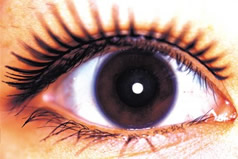Feb 7 2005
 The eyes are not only a mirror of a soul, but also a medical record. Their thermal radiation can indicate a disease even before clinical signs appear. Investigations in this area conducted by Russian scientists have been supported by the research program of the Russian Academy of Sciences called “Abstract Sciences for Medicine”.
The eyes are not only a mirror of a soul, but also a medical record. Their thermal radiation can indicate a disease even before clinical signs appear. Investigations in this area conducted by Russian scientists have been supported by the research program of the Russian Academy of Sciences called “Abstract Sciences for Medicine”.
Russian biophysicists under the guidance of G.R. Ivanitsky, Corresponding Member of the Russian Academy of Sciences, are developing the system for rapid disease diagnostics by eyes' thermal radiation. The method may be particularly useful during epidemic when it is necessary to assess promptly the state of health of the people coming from infected regions, this being done directly at railway stations and airports.
Physicians have always taken the patients’ temperature. This is a rather reliable indicator of the state of health, although some diseased are not accompanied by noticeable rise in temperature. The thermometer is usually placed under the tongue, in the armpit, in the external acoustic meatus or the rectum. Such methods do not suit for remote rapid diagnostics of people in a crowd. Instead of a traditional thermometer, Russian researchers suggested to use cameras recording infrared radiation of people, which would allow to take temperature promptly at a distance. Infrared cameras determine the temperature with precision of up to several hundredth of a degree. During mass diagnostics, it is most convenient to take the temperature of face – a constantly open part of the body. The warmest part of the face is eyes. The eye glow more intensely than the skin in the infra-red range, as they contain six hard-working muscles each, a ramified blood supply system and lachrymal glands. The temperature in the vicinity of eyes normally reaches 36.5 degrees C.
To get a thermal portrait of the healthy person’s eyes, the researchers examined 20 relatively healthy persons at the age of 20 through 65. It has turned out that the temperature in various points of the eye is different and it changes depending on how long a person is looking without winking. After the eye is opened, the temperature first drops by approximately one degree C, then it grows up, and then it decreases evenly to reach the final stationary value within 20 seconds after the eyelid was lifted. When adaptation capabilities of the eye’s blood vessels are decreased, it takes twice as long for the temperature to settle down. The temperature curves of the left and the right eye may have different shapes. The researchers have also identified that the eyelid’s temperature in the area of the bridge of nose is the highest and it can be used as a remote diagnostic criterion.
Russian biophysicists are convinced that the thermal portrait of an eye would change in case of a disease. It is common knowledge that an experienced diagnostician can say a lot by the appearance of eyes about a patient’s state of health. The eyes respond to both infectious and functional diseases. Hydropic bed, eyeball reddening, change of intraocular pressure – all these reflect the state of nervous and endocrine systems, hematosis and blood circulation systems, state of digestion, kidneys functioning, and also a diversity of infectious diseases. However, symptoms of a disease become noticeable when the disease has already gone too far. Probably, recording of small temperature deviations in the infra-red range would facilitate finding criteria for early diagnostics of a disease. From this perspective, the eyes can serve as one of thermal markers with the most intense luminescence.